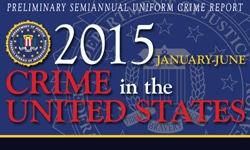FBI Announcement: Preliminary 2015 Crime Stats
Preliminary 2015 Crime Stats Released
 The FBI’s latest Preliminary Semiannual Uniform Crime Report, which contains data from January to June of 2015, revealed overall declines in the number of property crimes and overall increases in the number of violent crimes reported by law enforcement when compared to figures from the same time in 2014. According to the report, property crime was down 4.2 percent overall from 2014, and violent crime was up 1.7 percent overall.
The FBI’s latest Preliminary Semiannual Uniform Crime Report, which contains data from January to June of 2015, revealed overall declines in the number of property crimes and overall increases in the number of violent crimes reported by law enforcement when compared to figures from the same time in 2014. According to the report, property crime was down 4.2 percent overall from 2014, and violent crime was up 1.7 percent overall.
The publication features four tables—three which detail the percent change in offenses reported to law enforcement by population group, by region of the country, and by consecutive years back to 2011. The fourth table contains the number of offenses reported to law enforcement, by state, in cities with populations of more than 100,000.
The full Crime in the United States, 2015 report will be released later this year.
FBI Releases Preliminary Semiannual Crime Statistics for 2015
Statistics released today in the FBI’s Preliminary Semiannual Uniform Crime Report revealed overall declines in the number of property crimes reported and overall increases in the number of violent crimes reported for the first six months of 2015 when compared with figures for the first six months of 2014. The report is based on information from 12,879 law enforcement agencies that submitted three to six months of comparable data to the FBI’s Uniform Crime Reporting (UCR) Program for the first six months of 2014 and 2015.
Violent Crime
- All of the offenses in the violent crime category—murder and non-negligent manslaughter, rape (revised definition), rape (legacy definition), aggravated assault, and robbery—showed increases when data from the first six months of 2015 were compared with data from the first six months of 2014. The number of rapes (legacy definition) increased 9.6 percent, the number of murders increased 6.2 percent, aggravated assaults increased 2.3 percent, the number of rapes (revised definition) rose 1.1 percent, and robbery offenses were up 0.3 percent.
- Violent crime increased in all but two city groupings. In cities with populations from 50,000 to 99,999 inhabitants, violent crime was down 0.3 percent, and in cities with 500,000 to 999,999 in population, violent crime decreased 0.1 percent. The largest increase in violent crime, 5.3 percent, was noted in cities with 250,000 to 499,999 in population.
- Violent crime decreased 3.3 percent in non-metropolitan counties but rose slightly, 0.1 percent, in metropolitan counties.
- Violent crime increased in all but one of the nation’s four regions. These crimes were down 3.2 percent in the Northeast but increased 5.6 percent in the West, followed by rises of 1.6 percent in the South and 1.4 percent in the Midwest.
Property Crime
- In the property crime category, burglary offenses dropped 9.8 percent, and larceny-theft offenses decreased 3.2 percent in the first six months of 2015 compared with the same months from 2014. Only motor vehicle theft showed an increase (1.0 percent).
- Each of the city population groups had decreases in the overall number of property crimes. Law enforcement agencies in cities with populations under 10,000 inhabitants reported the largest decrease, 7.1 percent.
- Property crime decreased 12.3 percent in non-metropolitan counties and 6.0 percent in metropolitan counties.
- The West was the only region to show an increase (2.4 percent) in property crime. Reports of these offenses declined 8.0 percent in the Northeast, 7.0 percent in the Midwest, and 6.4 percent in the South.
Arson
In the UCR Program, arson offenses are collected separately from other property crimes. The number of arson offenses decreased 5.4 percent in the first six months of 2015 when compared with figures for the first six months of 2014. Three of the nation’s four regions reported decreases in the number of arsons. Arsons were down 14.6 percent in the Northeast, 7.1 percent in the South, and 4.4 percent in the West. However, in the Midwest, arson offenses rose 0.5 percent.
Arson offenses were down 14.0 percent in cities with populations under 10,000, the largest decrease within the city groupings. The only city grouping to experience an increase was in those cities with populations from 500,000 to 999,999, where arson offenses rose 11.9 percent. Arsons decreased 16.4 percent in non-metropolitan counties and 4.7 percent in metropolitan counties.
Revised Definition of Rape
In 2013, the FBI’s UCR Program initiated the collection of rape data under a revised definition within the Summary Based Reporting System. The term “forcible” was removed from the offense name, and the definition was changed to “penetration, no matter how slight, of the vagina or anus with any body part or object, or oral penetration by a sex organ of another person, without the consent of the victim.”
The number of rape incidents reported using the revised definition, as well as the number of rapes submitted using the legacy definition, are both included in this report in separate columns in each table. The rape figures for those agencies that changed from reporting rape under the legacy definition in 2014 to the revised definition in 2015 are not included in the trend calculations for Tables 1-3, but they are included in Table 4. Please note: Rape data reported for 2014 and 2015 cannot be aggregated by all agencies. Instead, two distinct groups of agencies (those reporting using the legacy definition and those reporting using the revised definition) are used for calculating trends. Therefore, the percent changes from one year to the next within each group are calculated with fewer agencies than in recent years. Offenses with fewer counts are often sensitive to minor differences when calculating trends. More information about this subject is presented in footnotes and data declarations for each table.
Caution against ranking: When the FBI publishes crime data via its UCR Program, some entities use the information to compile rankings of cities and counties. Such rankings, however, do not provide insight into the numerous variables that shape crime in a given town, city, county, state, tribal area, or region. These rankings lead to simplistic and/or incomplete analyses that can create misleading perceptions that adversely affect communities and their residents. Only through careful study and analyses into the range of unique conditions affecting each local law enforcement jurisdiction can data users create valid assessments of crime. The data user is, therefore, cautioned against comparing statistical data of individual reporting units from cities, metropolitan areas, states, or colleges or universities solely on the basis of their population or student enrollment.





I have been contacted recently as of yesterday at 3:30pm and communicating with a man name Edward Harper since April 5th 2016. His e-mail address is edward.harper900@gmail.com He wants you to believe he is your soul mate Romance Scam. Then he pops the question to send money for his son birthday that Anthony in Africa who is taking care of him while he is serving in Iran and they don’t have money for a birthday party. The boy goes by Paul his email address is paul.long1957@yahoo.com After the son contacts you They get Anthony to give you the drop off money gram. in Guana Anathony Adoko Country Guana zip code 00233 Bank Money Gram. Anthony uses the ph # of 233240069188